6 of the best Tasmanian adventures
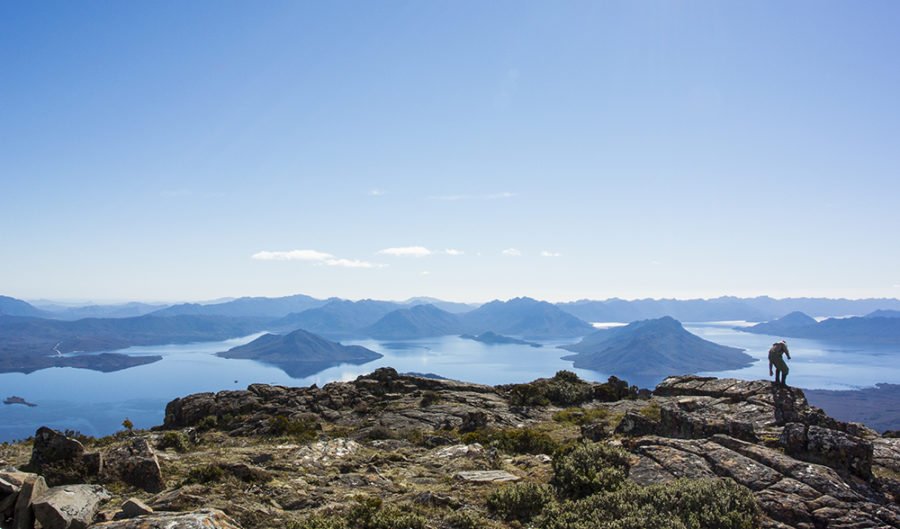
FROM TACKLING THE many walking tracks that traverse the island’s epic southwest wilderness region and climbing its remote peaks, to experiencing a world-rated whitewater river adventure and riding amazing MTB trails that have helped rejuvenate a town, it’s all here – and so close to mainland Australia there’s really no excuse to not explore this adventurer’s paradise.
1. TREK: South Coast Track
Best time: October to April More info: www.parks.tas.gov.au
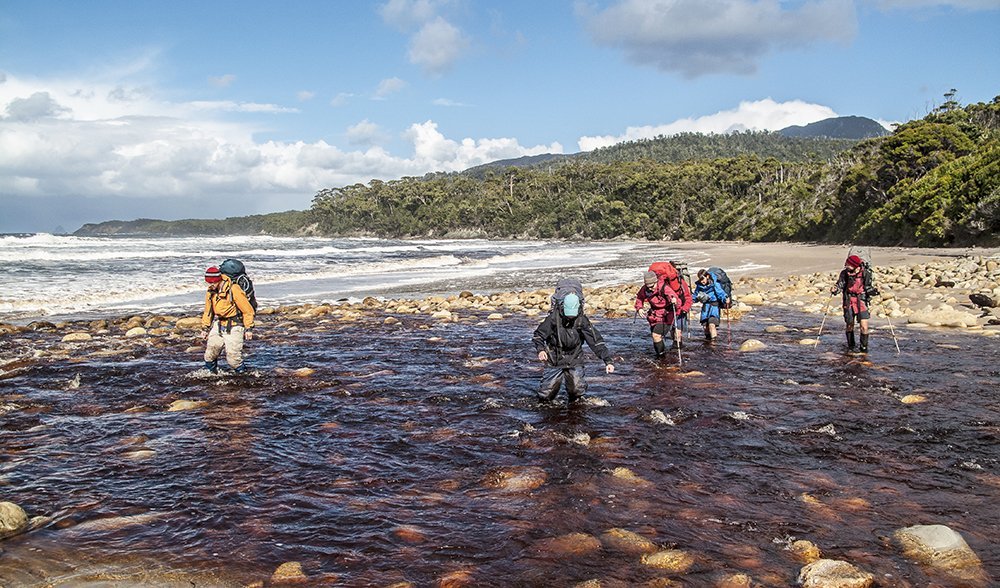
Every time the topic of “best Tassie walks” comes up in the Australian Geographic Adventure office, there’s a mad scramble to voice our favourites. But there’s always one standout that all our contributors agrees on: the South Coast Track.
This 85km adventure can take walkers between seven and nine days to complete, and they’ll be confronted by strong winds, as the track is abutted on its southern and northern sides by the wild Southern Ocean and the wilderness area encompassed in the Southwest National Park.
To walk the South Coast Track, you first have to fly; a small plane trip from Hobart delivers walkers to the track start at Melaleuca. This track offers every challenge across remote, ever-changing terrain for the entire time you’re on it. The South Coast Track is most famous for its mud, and you’ll walk through (and nearly be swallowed by) plenty of it. Don’t expect to have dry socks after the first day but do enjoy it as part of the unique South Coast Track experience. As well as the mud there are the vast button-grass plains, wild tannin-stained rivers, creeks and lakes (of which you will cross many – mostly by foot, but one via a rowboat at New River Lagoon), expansive and lonely beaches, cracking sunrises and sunsets, majestic sea cliffs battered by the southern ocean, memorable campsites, and the midway challenge of traversing the mighty Ironbound Range – a tough but rewarding 900m ascent and then descent of an exposed mountain (we suggest a layover day after this).
If this all sounds scary, it’s not meant to be; immersing yourself in one of the world’s last true wilderness areas you’re going to expect a few challenges but what makes the South Coast Track a near-automatic choice on any ‘best walks’ list is the fact that it has just the right amount of challenge, mixed with an incredible dose of spectacle that makes the effort more than worthwhile. Oh, and just to ensure it does rank so highly, your last day on the track is rewarded once you arrive at the pretty seaside village of Cockle Creek, with an awesome pub lunch and obligatory beverage (or two) to celebrate the achievement.
In terms of preparation, you have to be reasonably fit and able to walk with a full backpack (whether guided or unguided, you will need to carry all your food and gear – there is a restock point halfway) for around five to six hours a day. One essential in terms of gear is a dry set of clothes (and socks) for when you get to camp; after a day slogging through mud and water crossings, putting on dry clothes will feel like a true luxury. And of course, there’s the weather; this writer tackled the South Coast Track during the peak of summer (February) and was confronted with days ranging from -5°C when traversing the Ironbounds to a balmy 35°C on the last day, with a mix of rain, sunshine and strong winds throughout the trip. Yep, we’re again making the South Coast Track sound like a bloody big, slightly scary adventure – and it is, but in a truly awesome way, and one that you’ll never forget. It’s epic. – Justin Walker
2. TREK: Mt Anne Circuit
Best times: November to April More info: www.tasmanianexpeditions.com.au
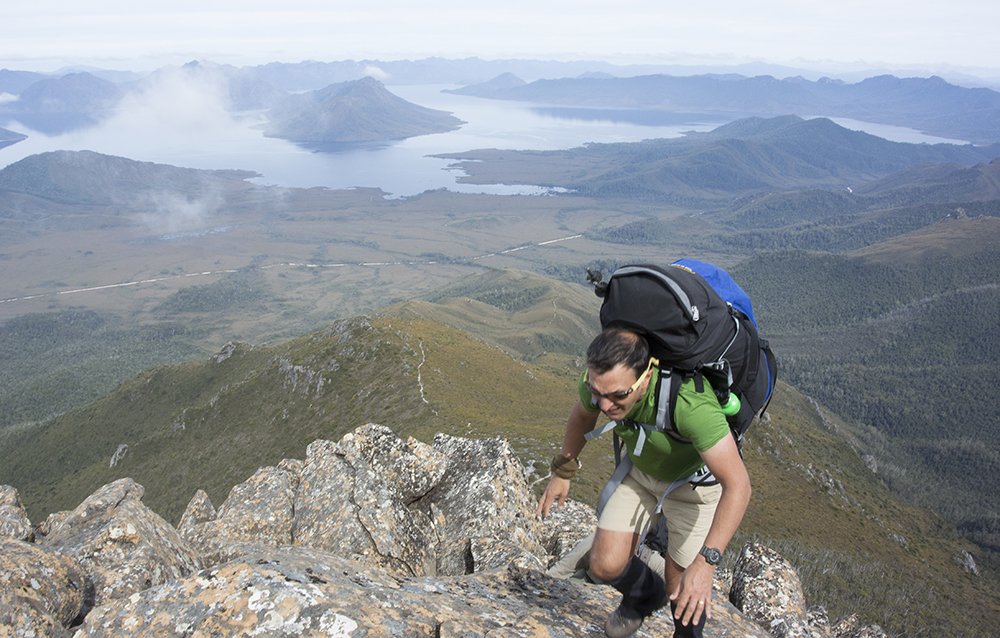
The great thing about Tasmania’s best walks is more than a few of them fit nicely into a weeklong escape for those living on the mainland. The Mt Anne Circuit is an example of this, but it is also a challenging walk that earns its bucket-list nomination for far more than just convenience: it is an absolute cracker of a four-day trek through Tassie’s rugged southwest.
You can fit a lot of adventure into four days if you really try – and the Mt Anne Circuit adheres to that ethos; the circuit throws walkers straight into it on day one, with a long but steady 750m ascent to the first campsite, aptly dubbed High Camp. The views back across Lake Pedder from here are amazing, and only topped by those who are keen enough for an afternoon scramble up higher to the top of Mt Eliza (1189m). We’d thoroughly recommend doing this, though, if you have the time; without your heavy packs on, it is a relatively short (around one hour), steep ascent up and over numerous boulders to the summit. From this lofty viewpoint, the views are incredible, ranging across Lake Pedder and then south toward more of the wild and mountainous terrain that Tassie’s southwest is famous for.
The Mt Anne Circuit’s other claim to fame is, funnily enough, the peaks you traverse during it. It is day two when walkers reach the circuit’s namesake peak; after leaving High Camp in the morning and – again – ascending Mt Eliza, you spend a couple of hours walking across the Mt Eliza Plateau before tackling some boulder scree and then you reach the junction of the track to Mt Anne itself.
The climb up Mt Anne won’t suit those with an aversion to high exposed areas, but for those who are up for it, the climb/scramble up the cliffs at the base of the peak leads to more balanced walking along exposed parts of the mountain to the summit and another epic view.
Once back on the main track it is only another 30 minutes to what this writer rates as one of Tassie’s best campsites: Shelf Camp. Perched up on a massive rock shelf, the campsite looks back across a deep valley to Mt Anne to the north, and the equally majestic Mt Lot and The Notch to the south. The campsite location is gobsmacking and also offers walkers a view of the next day’s epic: traversing Mt Lot and The Notch on the way to the lower-down Judd’s Charm camp.
If there’s one day that can possibly stand out from the others on the Mt Anne Circuit, it is day three and the traverse of The Notch. From Shelf Camp walkers have to traverse a massive scree field (it can take 2.5 hours to cover 1km), which also includes a few pack hauls and short abseils/rope-assisted descents before an even more epic section where you have a 15m exposed climb up the other side of The Notch, onto the dolerite walls of Mt Lot. The terrain is extremely rocky and scree-filled, but once you reach the summit of Mt Lot, the landscape changes once again. Descending Mt Lot, along Lightning Ridge, involves plenty of rock-hopping initially, before walkers are plunged into a landscape of dense rainforest, filled with giant pandanus and ferns, and muddy track sections to keep you on your toes before you reach relatively open ground and another hour of walking to the pretty Judd’s Charm campsite, nestled alongside a huge lake.
As with all Tassie treks, the last day on the Mt Anne Circuit is no stroll, with a lengthy traverse of a low plateau (keep your eye out for freshwater crayfish in the small creeks) before you descend rugged, rocky terrain to the Anne River plains and the ubiquitous button grass and mud-filled track (this writer witnessed a trek guide, who shall remain nameless, disappear nearly to his waist in one boggy section) that takes you to track’s end at Red Tape Creek.
The Mt Anne Circuit, like all multiday jaunts in Tassie, requires you to be fit and carry gear for all conditions, but if there’s ever a walk that fits the bill of “best walking bang for your bucks”, this is it folks. You’ll do it once, and then you’ll want to do it again, and again… – JW
3. MTB: Blue Derby
Best time: All year More info: www.ridebluederby.com.au

The Blue Derby mountain bike trail network is a mountain bike miracle. Just a few years ago, the tiny town of Derby, located about an hour east of Launceston, was on its last legs. A tourist driving by could’ve sneezed and missed it entirely. There were a couple of pubs with locals pouring themselves Boag’s Lagers on a Tuesday morning, and a coffee shop that was open less frequently than the North Korean border. Since the local mine shut, things had been on long slide.
But mountain biking has completely turned this town around; since the Blue Derby network opened less than three years ago, Derby has become the single hottest name in Australian mountain biking. Its reputation has grown so quickly that in March 2017, Derby will play host to a round of the prestigious Enduro World Series, which is incredible considering there weren’t any “goat tracks” (as one local referred to the trails when we last visited) at all until recently.
This rise to prominence is no accident. The Tassie government is leading the way in Oz, recognising the huge potential of MTB tourism to drive economic recovery. Leading trail builders, World Trail, were called in to shape the incredible landscape around Derby into a network without Australian parallel. Over three stages of development, they’ve crafted an amazing number of special trails, with enough variety to keep all levels and styles of riders occupied for at least two or three days of non-stop riding.
The Blue Derby network spans the region between the town of Derby and the Blue Tier, a distant range of mountains that was stripped bare by tin miners. This huge area takes in remarkable terrain, Tassie style, full of towering old growth forest scattered with a mix of abandoned equipment that tells the tale of the region’s mining history.
One thing that makes Blue Derby so appealing is the proximity of the trails to town – you can roll out of the pub and be into the singletrack in under a minute. Linking up a quick hour loop is easy, or you can embark on a half-day mission out in the hills and take on the awesome Dam Busters or Krushka’s trails. However, to get the most out of Derby, make sure you book a shuttle with local service Vertigo MTB, and get dropped up at Big Chook which starts miles and miles away up in the Blue Tier. After a perspective-changing descent, you’ll find yourself at the Weldborough Hotel. Grab a pub lunch, then press on to yet another huge descent with Atlas, before eventually dropping back into Derby, completely wrecked from an adrenaline comedown.
Accommodation options aren’t numerous yet (though locals are starting to latch onto the B&B potential), so you’ll want to get in quick at busy times of year, or there’s camping available alongside the river, which ain’t half bad.
This town might just represent the best weekend getaway in Aussie mountain biking at moment. No matter how you like to ride, Blue Derby will blow you away. Believe the hype and check it out. – Chris Southwood
4. PADDLE: The Franklin River
Best time: October to March More info: www.worldexpeditions.com
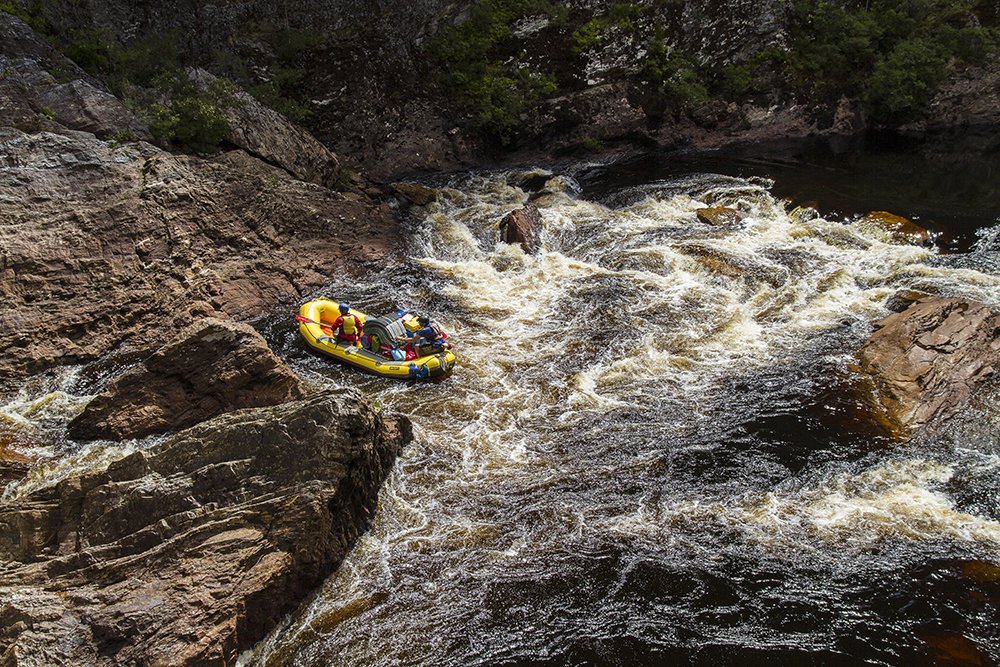
It’s hard to argue with the rest of the world when it comes to describing just how epic a whitewater-rafting (or kayaking) trip down Tassie’s Franklin River is. For that, we only have to point to respected US magazine Outside rating the Franklin River as the world’s best whitewater adventure. Or, a lot closer to home, we could just unblock our ears and – yet again – listen to Australian Geographic Adventure Editor Justin Walker rave about his experience on the river as “my favourite outdoor adventure of all time”, over and over and over again.
RELATED: Paddling the mighty Franklin
The sheer awesomeness of a rafting journey along the 125km of fast flowing, tannin-stained waters of the Franklin begins from the, er, very beginning once you grab that paddle and jump in the raft at the put-in point on the Collingwood River (a short distance away from the confluence of it and the Franklin). From here, and for the next nine days, every single moment on the river will become entrenched as a life-long memory.
It’s hard to say what’s the most memorable part of the experience; floating through Franklin-Gordon Wild Rivers National Park – a truly remote, near-inaccessible part of the southwest Tasmanian wilderness – or being challenged, scared and amazed by the many, many rapids along the way. The river’s rapids are all unique in terms of their varying degrees of length, ruggedness and challenge (you will portage the most dangerous, such as The Churn), but these wilder sections are brilliant fun, and compensated by sublime campsites such as Newland Cascades, where you get to shelter under ancient open cave overhangs, and listen to the constant roar of one of Australia’s last truly wild rivers beside your sleeping area.
The Franklin River can be run independently (but you must be very experienced) or you can opt for a guided trip, the latter a much better option for most. There are various companies running trips ranging in duration from seven to 10 days; we’d highly recommend World Expeditions’ nine-day Franklin River experience. This trip combines great guides with a more leisurely traverse of the river, and the food is amazing. Having more time on the river also means you get to tackle a few side trips, including a stopover at Rock Island Bend and a chance to explore the aptly-named Lost World, a moss-clad wonderland that nearly looks too pretty to be real.
From packing up camp and loading the rafts with gear each morning to tackling Grade V rapids and portaging tougher ones via cliff-side paths, the pulse of the ‘river life’ will soon have you wishing you could stay here permanently. Of course, beside the paddling there is also ample time to simply marvel at the landscape you are floating through; the valleys and hills at the start soon give way to narrow river sections walled-in by mighty cliffs through the famous Grand Ravine, before opening up to the still heavily forested areas at the confluence of the Franklin and Gordon rivers and journey’s end. It’s an incredible paddling adventure, and more than worthy of its global standing as one of the best whitewater adventure you can do. – JW
5. CLIMB: The Tasman Peninsula
Best time: All year More info: www.thesarvo.com/confluence/display/thesarvo/Climbing

Jutting out of the East Coast of Tasmania, only an hour so drive southeast of Hobart, is the Tasman Peninsula, a rugged and remarkable promontory lined by precipitous dolerite cliffs plunging into the Tasman Sea. While there are other areas in Tasmania with a higher density of routes, here you will find some of the most iconic and unique climbs in Australia, routes that lure climbers from around the globe.
On the eastern edge of the peninsula is beautiful Fortescue Bay, and a 90-minute walk from the campground is Tassie’s most famous rock climb, the Totem Pole, a gravity-defying 4m-wide pillar of dolerite that rises 60m from a sea-swept notch between the mainland and another larger pillar called the Candlestick. The first climber to reach its summit, legendary 60s hard-man John Ewbank, described it thus: “Take a matchstick, change it into dolerite. Multiply it 1600 times. Stand it upright in a heavy swell, then swim away before it topples over.” During their 1968 ascent, Ewbank and partner Alan Keller had to bivouac on the summit during a storm and Keller reputedly dreamt during the night that he could feel the pillar moving in the wind.
Ewbank and Keller climbed to the summit using ‘aid’ (pulling on wedges, bolts or pitons), but the Totem Pole was finally free climbed in 1995 at the relatively modest grade of 25. Today, during the summer climbing season, the Totem Pole gets many ascents, most by its easiest route, the Free Route (via the Deep Play first pitch). The route is unequivocally one of the best in the world, not just for its stunning location and superb climbing, but also because it’s an adventure – climbers have to abseil down into the notch and swing across the sometimes very rough sea to set up a hanging belay on the pillar itself, where they will often get hammered by spray or waves. Then, on reaching the top of the route, they have to set up a Tyrolean traverse back to the mainland, swinging back across a 60m chasm below.
If you love summiting pillars, also accessed from Fortescue Bay is the Moai, a dolerite pillar that is not as high or as narrow as the Totem Pole, but which can be climbed at a more moderate grade and with fewer access and descent issues. Further west on the Tasman Peninsula is another popular although hard-to-reach dolerite pillar, Pole Dancer (21). Pole Dancer is located out at the very tip of Cape Raoul, a kilometre-long ridge of dolerite pillars and cliffs that bend out into the ocean like the spine of an ancient titanic dinosaur. Pole Dancer is only a short route, but it’s an adventure getting to it: a two hour walk is followed by hours of scrambling, abseiling and roped climbing to get to the end of the pillar (passing a stinky seal colony), then climbing the route itself, which is often buffeted by a stiff Southern Ocean breeze. It’s a memorable day that often requires all the hours of daylight (bring a head torch).
For more regular cliff-climbing action, head north from Cape Raoul and visit Mt Brown. If, after all the mind-bending summits you are after something a little less outrageous, head to the Paradiso, a stellar sport climbing destination on wind- and water-scooped dolerite with routes up to grade 30 (but mostly in the mid 20s). For more outrageous, mind-bending climbing, head further out Mt Brown and abseil a couple of hundred metres down towards the breakers smashing below, and climb back out one of the three multi-pitch routes that make their way back up this mighty face which looms over the moody Southern Ocean. – Ross Taylor
RELATED: Top 10 Australian mountains to climb
6. Family camping: Bruny Island
Best time: September to April More info: www.campingatbrunyisland.com
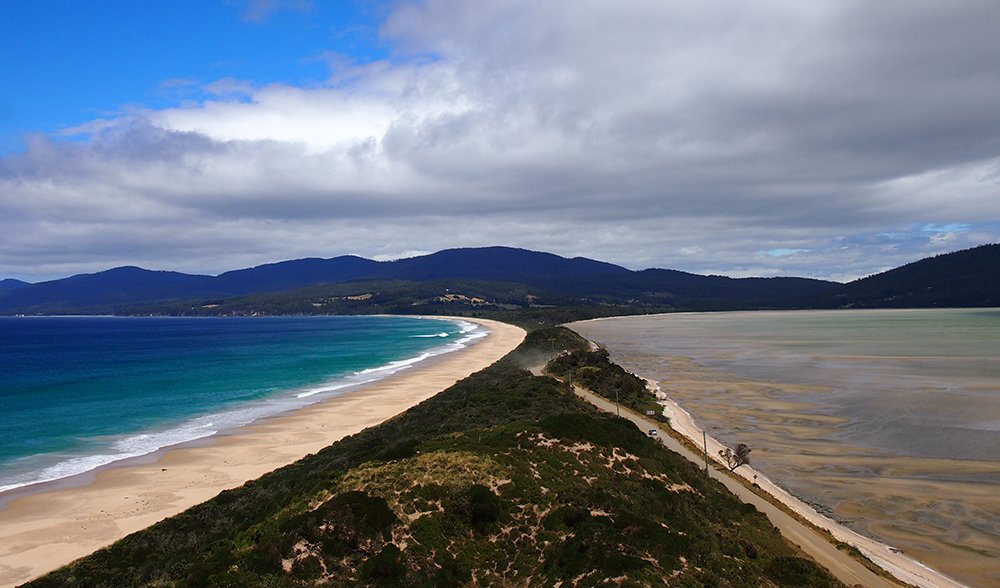
There’s no shortage of idyllic camping spots around Tassie, but our standout recommendation for the ultimate family location is a quiet spot down on the south end of Bruny Island.
There’s a 50-acre private forest, with nearly a kilometre of private coastline, called Camping at Bruny Island. Wedged between Cloudy Bay and the lagoon, the facility can handle up to about 18 groups at once. The pet-friendly site is broken up into five small areas that welcome both tents and camper trailers, and it’s designed well enough that you could keep to yourself, or make friends with the other one or two families that might share your neck of the woods.
There’s a group camping area with a communal campfire and shelter on the lagoon side, 60m from the water, which is perfect if you’re travelling with multiple families. On the beach side there are two smaller areas, one that also has a communal shelter. Nestled just outside these three areas are two little private nook locations, providing some privacy and seclusion. All of the sites are close to flushing toilets and running water.
The location of the site means that you can dip in and out of the wild and developed parts of Bruny Island as the family wants to. Within walking distance from the site are ideal fishing and diving locations, two surf breaks and access to bike and walking tracks, as well as the lagoon. The site is also just a few kilometres from the stunning South Bruny National Park, which features towering cliffs, excellent bird-watching sites and long sandy beaches.
The whole of the island is available for exploring though – there are short boardwalks and rainforest walks that will suit the youngest of the family, or longer walks such as the demanding six-hour circuit around the Labillardiere Peninsula, which takes you past the historic Cape Bruny Lighthouse, the fourth lighthouse built in Australia.
One of the best things about this campsite is the warm welcome – after you pass the paradoxically stern signs at the entrance, you’ll be waved in with enthusiasm. The managers will supply you with firewood, introduce you to the dogs and you can even arrange to hire camping equipment if necessary.
The campsite is about two hours south of Hobart, and you’ll need to drive first to Kettering, which should take about half an hour from the capital, and then catch a ferry south. For a single vehicle under 6m, the cost is less than $40, though it increases if you’re towing a trailer. The ferry runs hourly in winter, and more frequently through the summer. After landing in Bruny, head south over the Neck and past Alonnah. Bookings required. – Lauren Smith
RELATED: Road trip: Tasmania
Tasmania: The essentials
Getting there: Qantas, Virgin and Jetstar all fly to Hobart and/or Launceston. Alternatively, you can drive to Melbourne and hop aboard the Spirit of Tasmania ferry.
Best time to go: Tassie is a destination that can be visited all year round, but be aware it does get very cold in the winter months.
Walking: For independent walkers see www.parks.tas.gov.au. For guided treks see www.tasmanianexpeditions.com.au.
MTB: The Blue Derby Trails are accessed from the township of Derby, where there is plenty of accommodation available, as well as access to bike hire and bike shuttles to trail heads. See www.ridebluederby.com.au.
Camping: For caravan and campgrounds see www.turu.com.au. For Bruny Island’s camping options see www.campingatbrunyisland.com.
More info: For all other things Tasmania see www.discovertasmania.com.

